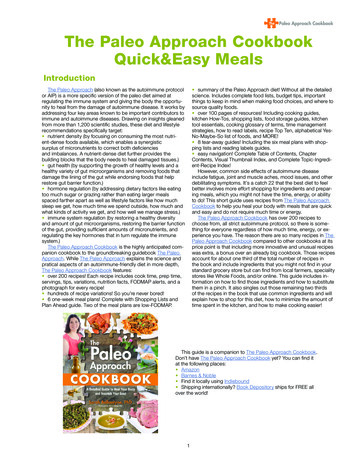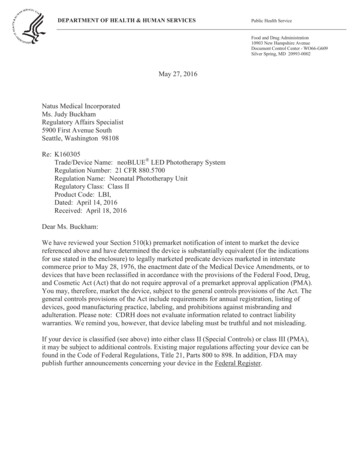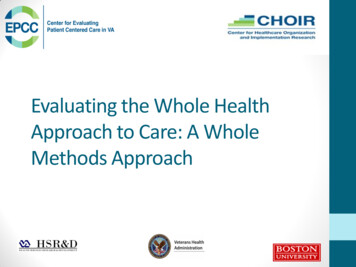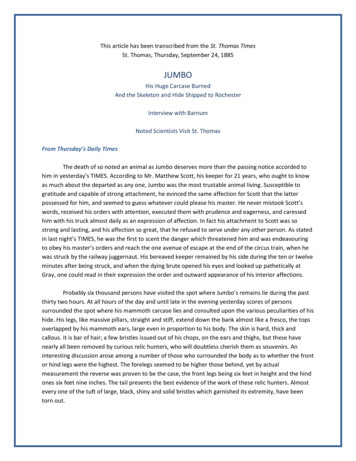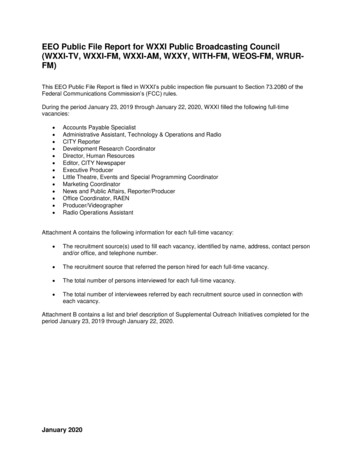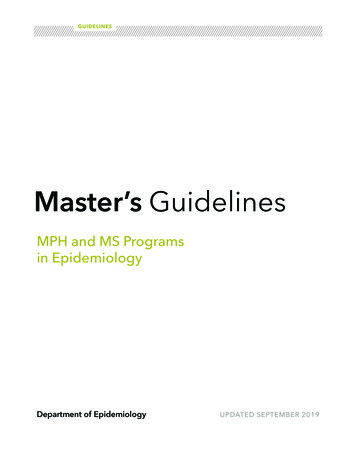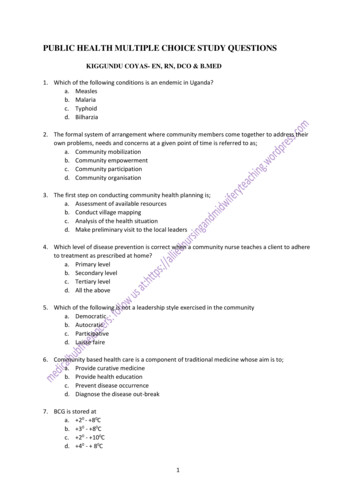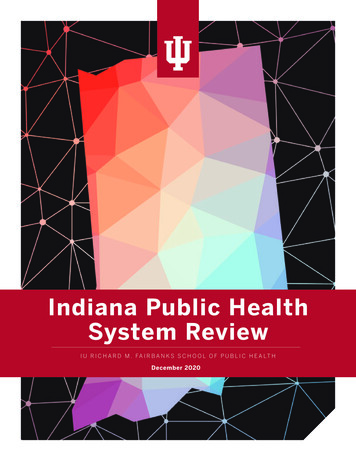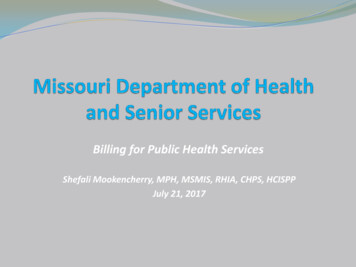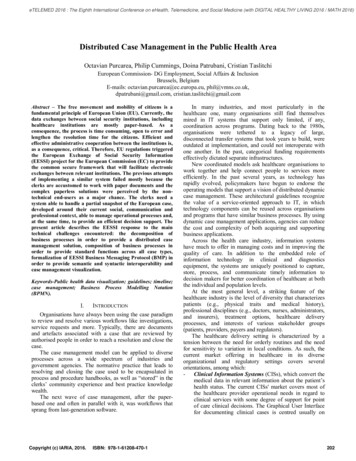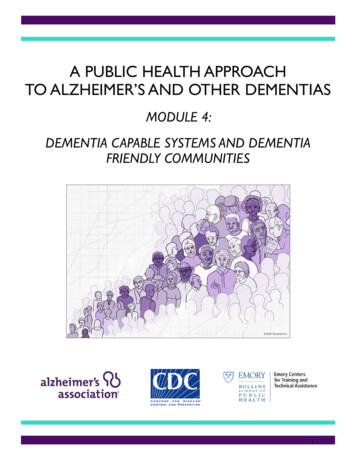
Transcription
A PUBLIC HEALTH APPROACHTO ALZHEIMER’S AND OTHER DEMENTIASMODULE 4:DEMENTIA CAPABLE SYSTEMS AND DEMENTIAFRIENDLY COMMUNITIES1
Table of ContentsAbout Module 4 .3Learning Objectives .3Competencies .4Layout of Module 4 Faculty Guide . .5How to Use the Materials .5Student Engagement Options .6Discussion Questions .6Learning Activities .6Additional Reading .7Slide Guide .8PowerPoint Slides .64Sample Test Questions . .84Selected Case Studies-Module 4 .85Alzheimer’s Disease Video Resources 1002
Module 4: Dementia Capable Systems and Dementia Friendly CommunitiesABOUT MODULE 4This module is part of the Alzheimer’s Association curriculum, A Public Health Approachto Alzheimer’s and Other Dementias. Developed as part of a cooperative agreementwith CDC’s Healthy Aging Program, and in partnership with Emory University’s RollinsSchool of Public Health, this curriculum addresses cognitive health, cognitiveimpairment, and Alzheimer’s disease and is for use by undergraduate faculty in schoolsand programs of public health.Module 4: Dementia Capable Systems and Dementia Friendly Communities addressesthe public health response to the Alzheimer’s disease epidemic at the state andcommunity levels. The module describes the concept of a “dementia capable” system,which involves accommodating the needs of a population that experiences memoryloss, a variety of physical, cognitive, and behavior symptoms, and other co-morbidities.Module 4 explores how public health may support the development of such systems onstate and local levels through: public health research and translation, support servicesand programs, workforce training, and the creation of dementia-friendly communities.Module 4 contains the following topics: Public health research Support services & programs Workforce training Dementia friendly communitiesLEARNING OBJECTIVESAt the end of Module 4: Dementia Capable Systems and Dementia FriendlyCommunities, students will be able to: Define “dementia capable.” Explain how public health can contribute to the development of dementia capablesystems through: public health research and translation, support services andprograms, workforce training, and the creation of dementia-friendly communities. List at least 2 support services that may benefit a caregiver of someone withAlzheimer’s or dementia. Identify at least 3 professions that would benefit from receiving workforce trainingrelated to Alzheimer’s and dementia. Describe at least 2 components of a dementia friendly community.3
Module 4: Dementia Capable Systems and Dementia Friendly CommunitiesCOMPETENCIESModule 4 promotes basic learning that supports the development of certaincompetencies:Association of Schools and Programs of Public Health: Domain 1: Appreciate the role of community collaborations in promotingpopulation health. Domain 2: Discuss the interconnectedness among the physical, social, andenvironmental aspects of community health.Council on Linkages Between Academia and Public Health Practice: 1A1. Describes factors affecting the health of a community (e.g., equity, income,education, environment) 1A11. Describes assets and resources that can be used for improving the healthof a community (e.g., Boys & Girls Clubs, public libraries, hospitals, faith-basedorganizations, academic institutions, federal grants, fellowship programs) 8A3. Describes the ways public health, health care, and other organizations canwork together or individually to impact the health of a community 8A4. Contributes to development of a vision for a healthy community (e.g.,emphasis on prevention, health equity for all, excellence and innovation) 8A6. Describes needs for professional development (e.g., training, mentoring,peer advising, coaching)National Association of Chronic Disease Directors (NACDD): Domain 7: Articulate evidence-based approaches to chronic disease preventionand control.National Commission for Health Education Credentialing, Inc. (NCHEC): 1.7.4 Identify emerging health education needs. 3.3.2 Identify training needs.Disclaimer: This publication was supported by Cooperative Agreement Number 5U58DP002945-05,funded by the Centers for Disease Control and Prevention. Its contents are solely the responsibility ofthe authors and do not necessarily represent the official views of the Centers for Disease Control andPrevention or the Department of Health and Human Services.The mark "CDC” is owned by the US Dept. of Health and Human Services and is used with permission.Use of this logo is not an endorsement by HHS or CDC of any particular product, service, orenterprise.FACULTY GUIDE4
Module 4: Dementia Capable Systems and Dementia Friendly CommunitiesLAYOUT OF MODULE 4 FACULTY GUIDEThis guide is laid out in the following sections: Slide guide with talking points Sample test questions Case studies Video resourcesNote: Some slides in this module duplicate content from other modules and may beremoved as needed.HOW TO USE THE MATERIALS This module is one of four modules in this curriculum that were designed for useeither as a set or as stand-alone modules. Users are free to make changes to the materials to fit their needs, including:adding, modifying or removing content, graphics, talking points, discussionquestions or learning activities. The Faculty Guide for each module includes a slide guide that contains theinformation as presented in the slide, talking points, space for presenter notes,and references. The talking points included in the Faculty Guide should not be read word forword; each presenter should review the materials before delivering the materialto ensure familiarity and deliver the information in his/her own style. Delivery time will generally be 60-90 minutes per module, depending on classengagement, presenter style, and the addition or elimination of any content,discussion questions, or learning activities. Discussion questions are included in the slide deck of each module. These maybe modified or removed at the discretion of the presenter. Questions may alsobe used for other activities such as small group discussion or individual writingassignments. Video resources, a list of articles and case studies are also included to help inlearning more about the topics presented in each module. Test questions are provided with each module as an additional resource forfaculty. All materials are 508 compliant. (Note: if changes are made to the curriculum, itis recommended that changes continue to follow 508 compliance guidelines. Formore information on 508 compliance visit the Department of Health and HumanServices website: essible/checklist/)FACULTY GUIDE5
Module 4: Dementia Capable Systems and Dementia Friendly CommunitiesSTUDENT ENGAGEMENT OPTIONSIn addition to the PowerPoint slide deck and guide, there are additional resourcesincluded in this guide. These resources are designed to increase student engagementand enhance understanding of the concepts covered in this module. Following the slideguide, there is a series of case studies and a list of video resources. It is recommendedthat the presenter review these resources to determine if these additional materialswould be useful in illustrating the concepts covered in the module.DISCUSSION QUESTIONSThe following discussion questions are included in the slide deck: What is public health research? What does it mean to translate findings? (Slide10) How can public health research and translation be used to reduce the burden ofAlzheimer’s disease? (Slide 12) What kinds of support services might people with Alzheimer’s and theircaregivers need? (Slide 15) What is the role of public health in connecting people to the services they need?(Slide 19) What training should health care and direct care professionals receive? (Slide 24) What training should public health professionals receive? (Slide 26) What training should first responders receive? (Slide 28) Imagine you or someone you care about has Alzheimer’s or dementia. Whatmight be some of your concerns or fears about going out in your community?How could those be addressed at a community level? (Slide 32)LEARNING ACTIVITIESThe following learning activities may be used or adapted to enhance student learning: Conduct a brief observational study of the community in which you live, work, orgo to school. What characteristics could be considered dementia-friendly?What changes would be needed? How could public health support thedevelopment or growth of a dementia friendly community where youlive/work/study? Select one of the interventions described in the report, Translating Innovation toImpact: Evidence-based interventions to support people with Alzheimer’s diseaseFACULTY GUIDE6
Module 4: Dementia Capable Systems and Dementia Friendly Communitiesand their caregivers at home and in the community. Provide a brief descriptionof the program, including any challenges or gaps (that are identified or that yourecognize). How could public health support the expansion or improvement ofthis program? Document may be accessed from view/18#.VgFoUuvL6M4 Select a workforce (such as public health, health care, first responder, etc.) thatwould benefit from training on Alzheimer’s and dementia. Create an outline oftraining topics – what information would you present? What educationaltechniques would you use during the training?ADDITIONAL READING Bynum, Julie PW. "The long reach of Alzheimer’s disease: Patients, practice, andpolicy." Health Affairs 33.4 (2014): 3/4/534.short Lin, S. Y., & Lewis, F. M. (2015). Dementia friendly, dementia capable, anddementia positive: concepts to prepare for the future. The Gerontologist, 55(2),237-244. /2/237.shortFACULTY GUIDE7
Module 4: Dementia Capable Systems and DementiaFriendly CommunitiesSLIDE GUIDEThis slide guide accompanies the PowerPoint presentationfor this module. The right margin has been widened toallow the presenter to write notes.SLIDE 1:Module 4: Dementia Capable Systems and DementiaFriendly CommunitiesTALKING POINTS:This presentation entitled, Dementia Capable Systems andDementia Friendly Communities, is part of a curriculum forpublic health students entitled, A Public Health Approach toAlzheimer’s and Other Dementias. It was developed by theEmory Centers for Training and Technical Assistance for theAlzheimer’s Association with funding from the Centers forDisease Control and Prevention.This presentation addresses the public health response to theAlzheimer’s epidemic at the state and community levels andthe importance of dementia capable systems and dementiafriendly communities.8
Module 4: Dementia Capable Systems and DementiaFriendly CommunitiesSLIDE 2:Learning Objectives Define “dementia capable” Explain how public health can contribute todementia capable systems through: research andtranslation, support services/programs, workforcetraining, and dementia friendly communities List at least 2 services that may benefit a caregiverIdentify at least 3 professions that would benefit fromworkforce trainingDescribe at least 2 components of a dementia friendlycommunity TALKING POINTS:By the end of the presentation, you will be able to: Define “dementia capable” Explain how public health can contribute to dementiacapable systems through: research and translation,support services/programs, workforce training, anddementia-friendly communities List at least 2 services that may benefit a caregiver Identify at least 3 professions that would benefit fromworkforce training Describe at least 2 components of a dementia-friendlycommunityFACULTY GUIDE9
Module 4: Dementia Capable Systems and DementiaFriendly CommunitiesSLIDE 3:CompetenciesAssociation of Schools and Programs of Public Health: Domain 1: Appreciate the role of communitycollaborations in promoting population health. Domain 2: Discuss the interconnectedness among thephysical, social, and environmental aspects ofcommunity health.Council on Linkages Between Academia and Public HealthPractice: 1A1. Describes factors affecting the health of acommunity (e.g., equity, income, education,environment) 1A11. Describes assets and resources that can be usedfor improving the health of a community (e.g., Boys &Girls Clubs, public libraries, hospitals, faith-basedorganizations, academic institutions, federal grants,fellowship programs) 8A3. Describes the ways public health, health care, andother organizations can work together or individuallyto impact the health of a communityTALKING POINTS: (this slide can be edited as needed orremoved)The content in this presentation supports the development ofthe following competencies:Association of Schools and Programs of Public Health: Domain 1: Appreciate the role of communitycollaborations in promoting population health Domain 2: Discuss the interconnectedness among thephysical, social, and environmental aspects ofcommunity healthFACULTY GUIDE10
Module 4: Dementia Capable Systems and DementiaFriendly CommunitiesCouncil on Linkages Between Academia and Public HealthPractice: 1A1. Describes factors affecting the health of acommunity (e.g., equity, income, education,environment) 1A11. Describes assets and resources that can be usedfor improving the health of a community (e.g., Boys &Girls Clubs, public libraries, hospitals, faith-basedorganizations, academic institutions, federal grants,fellowship programs) 8A3. Describes the ways public health, health care, andother organizations can work together or individuallyto impact the health of a communityFACULTY GUIDE11
Module 4: Dementia Capable Systems and DementiaFriendly CommunitiesSLIDE 4:Competencies Cont.Council on Linkages Between Academia and Public HealthPractice (cont.): 8A4. Contributes to development of a vision for ahealthy community (e.g., emphasis on prevention,health equity for all, excellence and innovation) 8A6. Describes needs for professional development(e.g., training, mentoring, peer advising, coaching)National Association of Chronic Disease Directors (NACDD): Domain 7: Articulate evidence-based approaches tochronic disease prevention and controlNational Commission for Health Education Credentialing, Inc.(NCHEC): 1.7.4 Identify emerging health education needs. 3.3.2 Identify training needsTALKING POINTS: (this slide can be edited as needed orremoved)Council on Linkages Between Academia and Public HealthPractice (cont.): 8A4. Contributes to development of a vision for a healthycommunity (e.g., emphasis on prevention, health equityfor all, excellence and innovation) 8A6. Describes needs for professional development (e.g.,training, mentoring, peer advising, coaching)National Association of Chronic Disease Directors (NACDD): Domain 7: Articulate evidence-based approaches tochronic disease prevention and controlNational Commission for Health Education Credentialing, Inc.(NCHEC): 1.7.4 Identify emerging health education needs 3.3.2 Identify training needsFACULTY GUIDE12
Module 4: Dementia Capable Systems and DementiaFriendly CommunitiesSLIDE 5:Introduction: Dementia & Alzheimer’s Disease1 Dementia is a decline in mental ability severe enoughto interfere with daily lifeo Caused by damage to brain cells, primarilyaffects older adults Alzheimer’s disease is the most common form ofdementiao Progressive loss of memory and brain function,behavior and personality changeso As disease progresses, caregivers provideincreasing aid and assistanceo No cure and limited treatment options Huge financial and emotional burden on people withAlzheimer’s, their families, caregivers, and the healthcare system Public health plays important role in addressingAlzheimer’s disease through surveillance, prevention,detection, and support of dementia-capable systemsTALKING POINTS:Before we begin discussing dementia capable systems anddementia friendly communities in addressing Alzheimer’sdisease, it may be helpful to know a little more aboutAlzheimer’s and dementia.The term dementia is a general term for a decline in mentalabilities that is severe enough to interfere with daily life.Dementia, which is not a disease but a syndrome, ischaracterized by damage to the brain cells due to age, braininjury, other conditions or diseases or heredity.There are several types of dementia and most occur in thoseover 65; however, there are types of dementia that occur inthose younger than 65.1Alzheimer’s Association. 2016 Alzheimer’s Disease Facts and Figures.FACULTY GUIDE13
Module 4: Dementia Capable Systems and DementiaFriendly CommunitiesAlzheimer’s disease is the most common type of dementia.Alzheimer’s is a progressive disease that ranges from mild tosevere cognitive impairment that occurs over the course ofseveral years. There is no cure for Alzheimer’s. While thereare approved drug treatments, the goal of treatment is todelay or reduce symptoms, not to cure or reverse the courseof the disease.As the person with Alzheimer’s loses memory and function,caregivers, who are most often family members, are neededto provide increasing amounts of assistance. This assistancecan range from helping to manage finances and householdtasks to hands-on care, such as bathing, dressing, feeding andother activities of daily living. Given the nature of the diseaseand its increasing prevalence, there is a huge financial,emotional and physical impact on people with Alzheimer’s,their families, caregivers, and the health care system as awhole.Public health plays an important role in addressingAlzheimer’s disease through surveillance, prevention,detection, and support of dementia-capable systems.In this presentation, we will be focusing on dementia capablesystems and dementia friendly communities, both of whichinvolve government and health care agencies, organizationsand communities accommodating the needs of people withdementia and their caregivers through providing education,services and support within their community.Video supplements: “What is Alzheimer's disease?” TedEd.(run time: 3:49 mins)Link: https://www.youtube.com/watch?v yJXTXN4xrI8Or, “Inside the Brain: Unraveling the Mystery of AlzheimerDisease”. National Institutes of Health, NIH Senior Health.(run time: 4 /whatisalzheimersdisease/video/a2 na.html?intro yesFACULTY GUIDE14
Module 4: Dementia Capable Systems and DementiaFriendly CommunitiesSLIDE 6:Alzheimer’s: A Larger Context2 States/communities play significant roleo Assessing burdeno Risk reductiono Care services: health care, support servicesgovernment agencieso Public and private resources: transportation,grocery stores, places of worship, financialinstitutions,law enforcementTALKING POINTS:Alzheimer’s and dementia are often considered in terms ofthe toll these conditions take on individuals, families, andcaregivers.As an epidemic, Alzheimer’s and dementia also need to beaddressed within a larger context. States and communitieshave many people living with Alzheimer’s and otherdementias, as well as many others who are at risk fordeveloping these conditions.States must assess the burden of Alzheimer’s and dementiaand take steps to reduce risk and provide support to affectedpopulations.At a community level, individuals with Alzheimer’s anddementia and their caregivers rely on many care services,including health care, support services (in-home, community,and long-term care), and government
Aug 04, 2015 · Module 4: Dementia Capable Systems and Dementia Friendly Communities addresses the public health response to the Alzheimer’s disease epidemic at the state and community levels. The module describes the concept of a “dementia capable” system, which involves accommodating the needs o
